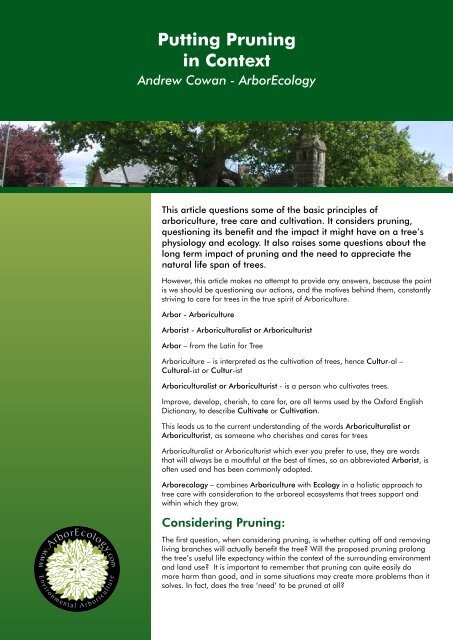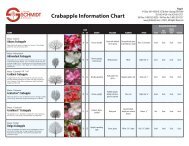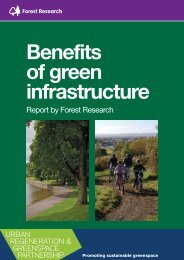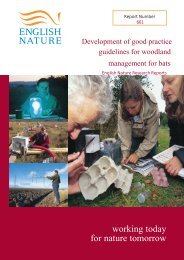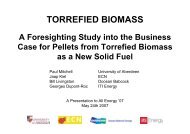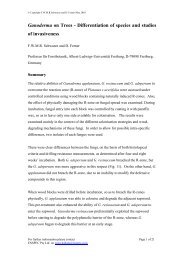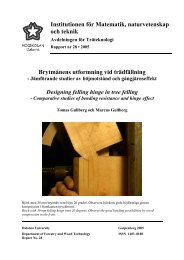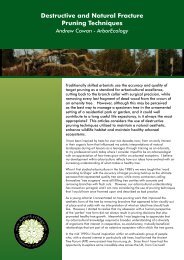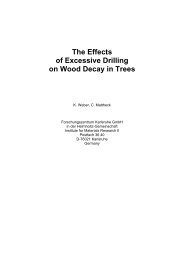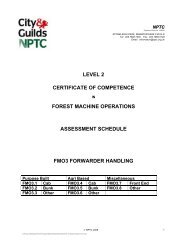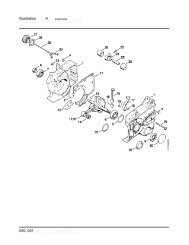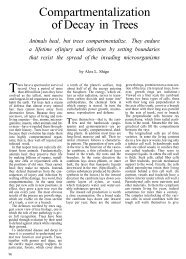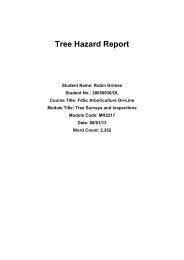Putting Pruning in Context Andrew Cowan - ArborEcology - Arbtalk
Putting Pruning in Context Andrew Cowan - ArborEcology - Arbtalk
Putting Pruning in Context Andrew Cowan - ArborEcology - Arbtalk
- No tags were found...
You also want an ePaper? Increase the reach of your titles
YUMPU automatically turns print PDFs into web optimized ePapers that Google loves.
Every cut made has the potential to change the growth characteristics ofthe tree. Remov<strong>in</strong>g liv<strong>in</strong>g foliage, by prun<strong>in</strong>g, affects the trees physiologyand future productivity. The reduction <strong>in</strong> leaf area that results fromprun<strong>in</strong>g will reduce the tree’s overall photosynthetic capacity, which islikely to affect susta<strong>in</strong>able growth on the pruned section, or the entiretree. <strong>Prun<strong>in</strong>g</strong> can therefore have a last<strong>in</strong>g impact on the viability of thetree and can directly <strong>in</strong>fluence its longevity.One of the major limitations of crown prun<strong>in</strong>g is that it has a veryone-sided impact on tree physiology. Before prun<strong>in</strong>g the tree will bema<strong>in</strong>ta<strong>in</strong><strong>in</strong>g a natural equilibrium of growth, throughout the crown ofleaves and branches, <strong>in</strong> balance below ground with<strong>in</strong> a broad spread<strong>in</strong>gsystem of roots, with their associated mycorrhiza. Raw materials areabsorbed from the soil, moved up through the transport system with<strong>in</strong>the trunk and branches to the leaves, where energy is produced throughphotosynthesis. By remov<strong>in</strong>g leaves and branches from the crown thearborist disrupts the balance, forc<strong>in</strong>g the tree <strong>in</strong>to a state of turmoil.Avenue of ancient sweetchestnut Castana setiva treesat Croft Castle, Herefordshire,England, UK.The casual observer, of the growth that appears after prun<strong>in</strong>g, could bemistaken for th<strong>in</strong>k<strong>in</strong>g that cutt<strong>in</strong>g off branches and reduc<strong>in</strong>g the tree’sleaf area is beneficial and encourages new vigour. This may <strong>in</strong>deedappear to be the case, but it is essential to remember that severelypruned trees will <strong>in</strong>itiate the production and growth of ‘water-sprouts’ or‘sap-risers’, as a response to the need for new foliage to readdress thebalance of photosynthetic capacity and energy requirements. To susta<strong>in</strong>this flush of growth the tree must draw on stored energy reserves, whichlimit the resources available to resist <strong>in</strong>fection, disease and decay.For arborists, charged with the responsibility of tree care, the primary prun<strong>in</strong>gconsiderations are those that affect the tree’s physiological condition, itsability to compete with pathogens and its durability with<strong>in</strong> a wider ecologicalcontext. <strong>Prun<strong>in</strong>g</strong> <strong>in</strong>fluences the trees physiological productivity: its ability to resistpathogens, its successful reproduction and its efficient use of natural resources.So, how often does the advice provided by arborists benefit the tree?“Except dur<strong>in</strong>g the n<strong>in</strong>e months before he draws his first breath,no man manages his affairs as well as a tree does.”- George Bernard Shaw -<strong>Putt<strong>in</strong>g</strong> <strong>Prun<strong>in</strong>g</strong> <strong>in</strong> <strong>Context</strong><strong>Andrew</strong> <strong>Cowan</strong>www.<strong>ArborEcology</strong>.comThis photograph of trees grow<strong>in</strong>g through the ru<strong>in</strong>s of an old house,illustrates that ultimately nature will have the last word.
This impressive ancient oak pollard, is grow<strong>in</strong>g<strong>in</strong> a rear garden of a residential property <strong>in</strong> WestWickham, Kent. The tree is thought to be <strong>in</strong> theregion of 600-700 years old. Residential housesnow surround the tree, which has been swallowedby the urban sprawl of London’s 1930’s suburbandevelopment. The houses either side have beengiven plann<strong>in</strong>g permission by the local authority tobuild extensions, which have placed more pressureon the tree and the responsibilities of its owners.The neighbours now compla<strong>in</strong>about the tree, which blockslight from their gardens andbedroom w<strong>in</strong>dows.Look<strong>in</strong>g beyond tree care:In most cases the real motivations beh<strong>in</strong>d tree prun<strong>in</strong>g are associated with thehuman values of visual aesthetics, amenity and recreation. This may, <strong>in</strong> part atleast, be due to our need to see trees as be<strong>in</strong>g worth someth<strong>in</strong>g, to have somepurpose or function, which we as humans can use. Whilst the management oftrees us<strong>in</strong>g prun<strong>in</strong>g practices such as pollard<strong>in</strong>g have enhanced their longevity,these techniques are now less frequently used as the need for the associatedresource has reduced. These trees may now be seen to have some historicsignificance, but their true value is <strong>in</strong> their importance as an ecological resourceof co-evolutionary organisms.The primary considerations of prun<strong>in</strong>g specifications are all associated with theimpact prun<strong>in</strong>g will have on the tree, but if tree care is the drive beh<strong>in</strong>d prun<strong>in</strong>g,how does the tree actually benefit? The answer is more often that the treedoes not benefit, with the exception perhaps of formative prun<strong>in</strong>g dur<strong>in</strong>g theestablishment stages, which may improve the structural form and stability of atree’s trunk and branch growth. However, even this is a human <strong>in</strong>terpretation of‘good’ structural form. <strong>Prun<strong>in</strong>g</strong> must therefore be considered with<strong>in</strong> the contextof understand<strong>in</strong>g tree physiology over time, while tak<strong>in</strong>g <strong>in</strong>to consideration theecological impacts.The po<strong>in</strong>t is that although the <strong>in</strong>stigation beh<strong>in</strong>d tree prun<strong>in</strong>g is associated and<strong>in</strong>extricably l<strong>in</strong>ked with human values, the implications have a direct impact onthe physiology of the tree and the ecological balance with<strong>in</strong> its environment. Thearborist must, as a person responsible for tree care, work with a knowledge,understand<strong>in</strong>g and respect for the arboreal ecosystem and not just the tree whichhappens to be the subject of the prun<strong>in</strong>g specifications. This is arborecology.Arborecology <strong>in</strong>corporates an appreciation of the ecological value of trees andan acknowledgement that they might have some <strong>in</strong>tr<strong>in</strong>sic value, because theysupport a diverse arboreal ecosystem, which is an essential part of the naturalworld to which we all belong. Informed management decisions can enhancetheir longevity with sympathetic prun<strong>in</strong>g, but sometimes to ma<strong>in</strong>ta<strong>in</strong> a susta<strong>in</strong>ableecological habitat with<strong>in</strong> populations of trees it becomes necessary to considerdestructive techniques to encourage the process of decay.<strong>Putt<strong>in</strong>g</strong> <strong>Prun<strong>in</strong>g</strong> <strong>in</strong> <strong>Context</strong><strong>Andrew</strong> <strong>Cowan</strong>www.<strong>ArborEcology</strong>.com“A th<strong>in</strong>g is right when it tends to preserve the <strong>in</strong>tegrity,stability and beauty of the biotic community.It is wrong when it tends otherwise.”- Aldo Leopold - ‘Land Ethic’ 1949
A life time to understand:Trees are one of the few organisms which have an average life expectancy thatexceeds our own (human) ‘three score years and ten’, yet we offer them verylittle respect for this achievement. In fact, trees figure so low on the day to dayagenda of modern life that the average person will rarely stop to consider theirvalue. However, when someone actually pauses to th<strong>in</strong>k of the contributiontrees make to their lives as an <strong>in</strong>dividual, or as a member of society, the list canappear endless.There is a grow<strong>in</strong>g recognition that trees have a part to play, from the calm<strong>in</strong>g<strong>in</strong>fluence they have on our everyday lives to their ability to sequester carbondioxide,which could <strong>in</strong>fluence the susta<strong>in</strong>ability of human survival on the planet.Many of these beneficial attributes are l<strong>in</strong>ked to the slow progression of treegrowth over their long life spans, which can frequently be measured <strong>in</strong> centuries.However, many trees are deprived of the opportunity to live out their naturallives, because of a human ignorance that <strong>in</strong>flicts its will on the world with anarrogance that fails to recognise that everyth<strong>in</strong>g is <strong>in</strong>tr<strong>in</strong>sically connected.The technological advancement of human society has created populationsof people who have lost track of their cultural connection with an area orcommunity, to the extent that they shuffle around their country and sometimes theworld, mov<strong>in</strong>g from place to place. Is it any surprise then, that the new owner ofa suburban residence has no qualms with fell<strong>in</strong>g an oak tree, which may havebeen planted over 100 years ago dur<strong>in</strong>g an era he/she feels no connection with?The person who fells the 100 year old oak, fails to appreciate its value andconsiders that his/her rights, to live <strong>in</strong> a place without trees, are greater than theaccumulative values and benefits of the one oak. However, the same personmay only live <strong>in</strong> the property for no more than a decade, less than a tenth of thetrees age. Which of the two has, earned or deserves the greatest right to life?“Generations pass while some trees stand,and old families last not three oaks.”- Sir Thomas Brown -L<strong>in</strong>gfield Oak Theengrav<strong>in</strong>g on the southface of the structureunder this grand oldoak tree, reads;“This cross was builtcirca 1473 to designatethe boundariesof Puttenden andBilleshurst Manor. TheCage for the detentionof petty offendersadded <strong>in</strong> 1773 was lastused <strong>in</strong> 1882 to deta<strong>in</strong>poachers.”Was the tree used tomark the boundarybefore the cross wasbuilt? Was it used as ahang<strong>in</strong>g tree?<strong>Putt<strong>in</strong>g</strong> <strong>Prun<strong>in</strong>g</strong> <strong>in</strong> <strong>Context</strong><strong>Andrew</strong> <strong>Cowan</strong>www.<strong>ArborEcology</strong>.com
Royal & Sussex Oak These two pictures need no words to expla<strong>in</strong> them, simplyto say; where would you rather spend a sunny summers afternoon?Learn<strong>in</strong>g the Compromise:In this over populated modern world there have to be compromises to ma<strong>in</strong>ta<strong>in</strong>some degree of harmony, and if we are to life <strong>in</strong> association with trees thecompromise is prun<strong>in</strong>g. There is rarely space <strong>in</strong> our crowded towns, cities andeven villages, for the mature size of trees. Some form of prun<strong>in</strong>g has to beconsidered to readdress the balance, but just because they are perceived to begrow<strong>in</strong>g <strong>in</strong> the ‘wrong’ place, does that mean they have lost their value?A tree may be deemed to require prun<strong>in</strong>g because it is considered to be ‘too big’,a ‘hazard’ or simply grow<strong>in</strong>g <strong>in</strong> a location where it is at odds, or out of context,with the surround<strong>in</strong>g land use. However, there is no reason to ignore its potentiallife expectancy, and the ecological values associated with it. <strong>Prun<strong>in</strong>g</strong> work mustbe completed with an understand<strong>in</strong>g of the physiological limitations that impacton the tree’s ability to react to the loss of liv<strong>in</strong>g foliage. <strong>Prun<strong>in</strong>g</strong> is all aboutcompromise!The reactive capacity of a tree will be compromised to some degree, depend<strong>in</strong>gon the prun<strong>in</strong>g techniques employed, and the volume of liv<strong>in</strong>g wood and foliagewhich is removed at any one time. When mak<strong>in</strong>g prun<strong>in</strong>g decisions the arboristmust consider the chronological age of the tree, because a tree <strong>in</strong> its formativeyears may be able to tolerate the loss of a large limb, but the same tree <strong>in</strong> full tolate maturity might suffer term<strong>in</strong>ally when <strong>in</strong>flicted similar treatment.An arborist who is responsible for large populations of trees, such as thoseowned and managed by local authorities or large parks and gardens, mustguard aga<strong>in</strong>st the use of generic prun<strong>in</strong>g specifications which do not take thetrees chronological age <strong>in</strong>to consideration. It is also essential that the samearborists keep records of these tree populations, and how they have beenmanaged. This will ensure cont<strong>in</strong>uity <strong>in</strong> the way <strong>in</strong> which trees are cared for.<strong>Putt<strong>in</strong>g</strong> <strong>Prun<strong>in</strong>g</strong> <strong>in</strong> <strong>Context</strong><strong>Andrew</strong> <strong>Cowan</strong>www.<strong>ArborEcology</strong>.com“Generations pass while some trees stand,and old families last not three oaks.”- Sir Thomas Brown -
The natural balance of tree ecology:It is well established now, through the work of mycological researchers likeLonsdale, Schwarze, Boddy and Raynor that many plant pathogens co-existfor extended periods of time, <strong>in</strong> harmony with their host. Although the fullsignificance of this has yet to be <strong>in</strong>terpreted from the observational researchcompleted to date. The concept that the organisms we consider to be pathogens(and therefore ‘bad’) offer a positive contribution to the arboreal ecosystem, doesnot require a ‘leap of faith’ or great foresight. However, it is equally importantthat we do not jump to conclusions.Thoughtless prun<strong>in</strong>g can <strong>in</strong>terfere with and <strong>in</strong>terrupt the natural balance betweensymbiotic and parasitic relationships with<strong>in</strong> the tree and associated arborealecosystems. The physiological, pathological and ecological impacts of prun<strong>in</strong>gwork will not be immediately apparent, because the tree and its associatedecosystem will react through adaptations which occurs over a period of years.Arborists must consider this when assess<strong>in</strong>g a tree by ma<strong>in</strong>ta<strong>in</strong><strong>in</strong>g a cautiousapproach that is not distracted by the presence or absence of familiar and eyecatch<strong>in</strong>g fungal fruit<strong>in</strong>g bodies.A greater understand<strong>in</strong>g and appreciation of the long life processes of trees isessential. An arborist responsible for the care of just one tree, can only hope tohave an <strong>in</strong>fluence for a fraction of its potential life span. However the prun<strong>in</strong>gdecisions that the arborist makes, can have a direct impact on the tree and itssusta<strong>in</strong>able life expectancy. A decision made today could have consequencesthat are experienced decades and possibly centuries <strong>in</strong> the future.Trees, as long lived organisms, are slow to react to changes <strong>in</strong> their environment.Our <strong>in</strong>creas<strong>in</strong>gly fast pace of life means that we can <strong>in</strong>flict change on oursurround<strong>in</strong>gs <strong>in</strong> quick succession. A tree, which may fall victim to this, will sufferstresses that could culm<strong>in</strong>ate <strong>in</strong> premature death after be<strong>in</strong>g forced <strong>in</strong>to a spiralof decl<strong>in</strong>e.“If we represent knowledge as a tree,we know that th<strong>in</strong>gs that are divided are yet connected.We know that to observe the divisions andignore the connections is to destroy the tree.”- Wendell Berry -<strong>ArborEcology</strong> Ltdwww.<strong>ArborEcology</strong>.com0845 658 1400


